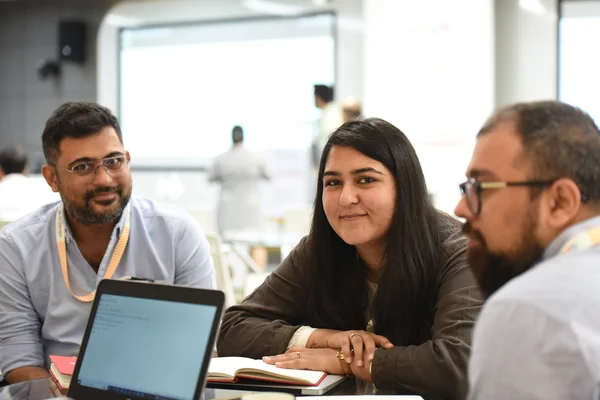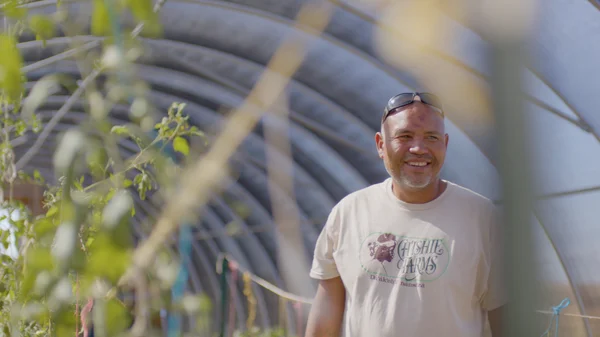Posted by Dave Hawkey, Software Engineer, Google Research

Two years ago we announced Project Guideline, a collaboration between Google Research and Guiding Eyes for the Blind that enabled people with visual impairments (e.g., blindness and low-vision) to walk, jog, and run independently. Using only a Google Pixel phone and headphones, Project Guideline leverages on-device machine learning (ML) to navigate users along outdoor paths marked with a painted line. The technology has been tested all over the world and even demonstrated during the opening ceremony at the Tokyo 2020 Paralympic Games.
Since the original announcement, we set out to improve Project Guideline by embedding new features, such as obstacle detection and advanced path planning, to safely and reliably navigate users through more complex scenarios (such as sharp turns and nearby pedestrians). The early version featured a simple frame-by-frame image segmentation that detected the position of the path line relative to the image frame. This was sufficient for orienting the user to the line, but provided limited information about the surrounding environment. Improving the navigation signals, such as alerts for obstacles and upcoming turns, required a much better understanding and mapping of the users’ environment. To solve these challenges, we built a platform that can be utilized for a variety of spatially-aware applications in the accessibility space and beyond.
Today, we announce the open source release of Project Guideline, making it available for anyone to use to improve upon and build new accessibility experiences. The release includes source code for the core platform, an Android application, pre-trained ML models, and a 3D simulation framework.
System design
The primary use-case is an Android application, however we wanted to be able to run, test, and debug the core logic in a variety of environments in a reproducible way. This led us to design and build the system using C++ for close integration with MediaPipe and other core libraries, while still being able to integrate with Android using the Android NDK.
Under the hood, Project Guideline uses ARCore to estimate the position and orientation of the user as they navigate the course. A segmentation model, built on the DeepLabV3+ framework, processes each camera frame to generate a binary mask of the guideline (see the previous blog post for more details). Points on the segmented guideline are then projected from image-space coordinates onto a world-space ground plane using the camera pose and lens parameters (intrinsics) provided by ARCore. Since each frame contributes a different view of the line, the world-space points are aggregated over multiple frames to build a virtual mapping of the real-world guideline. The system performs piecewise curve approximation of the guideline world-space coordinates to build a spatio-temporally consistent trajectory. This allows refinement of the estimated line as the user progresses along the path.
 |
| Project Guideline builds a 2D map of the guideline, aggregating detected points in each frame (red) to build a stateful representation (blue) as the runner progresses along the path. |
A control system dynamically selects a target point on the line some distance ahead based on the user’s current position, velocity, and direction. An audio feedback signal is then given to the user to adjust their heading to coincide with the upcoming line segment. By using the runner’s velocity vector instead of camera orientation to compute the navigation signal, we eliminate noise caused by irregular camera movements common during running. We can even navigate the user back to the line while it’s out of camera view, for example if the user overshot a turn. This is possible because ARCore continues to track the pose of the camera, which can be compared to the stateful line map inferred from previous camera images.
Project Guideline also includes obstacle detection and avoidance features. An ML model is used to estimate depth from single images. To train this monocular depth model, we used SANPO, a large dataset of outdoor imagery from urban, park, and suburban environments that was curated in-house. The model is capable of detecting the depth of various obstacles, including people, vehicles, posts, and more. The depth maps are converted into 3D point clouds, similar to the line segmentation process, and used to detect the presence of obstacles along the user’s path and then alert the user through an audio signal.
 |
| Using a monocular depth ML model, Project Guideline constructs a 3D point cloud of the environment to detect and alert the user of potential obstacles along the path. |
A low-latency audio system based on the AAudio API was implemented to provide the navigational sounds and cues to the user. Several sound packs are available in Project Guideline, including a spatial sound implementation using the Resonance Audio API. The sound packs were developed by a team of sound researchers and engineers at Google who designed and tested many different sound models. The sounds use a combination of panning, pitch, and spatialization to guide the user along the line. For example, a user veering to the right may hear a beeping sound in the left ear to indicate the line is to the left, with increasing frequency for a larger course correction. If the user veers further, a high-pitched warning sound may be heard to indicate the edge of the path is approaching. In addition, a clear “stop” audio cue is always available in the event the user veers too far from the line, an anomaly is detected, or the system fails to provide a navigational signal.
Project Guideline has been built specifically for Google Pixel phones with the Google Tensor chip. The Google Tensor chip enables the optimized ML models to run on-device with higher performance and lower power consumption. This is critical for providing real-time navigation instructions to the user with minimal delay. On a Pixel 8 there is a 28x latency improvement when running the depth model on the Tensor Processing Unit (TPU) instead of CPU, and 9x improvement compared to GPU.
Testing and simulation
Project Guideline includes a simulator that enables rapid testing and prototyping of the system in a virtual environment. Everything from the ML models to the audio feedback system runs natively within the simulator, giving the full Project Guideline experience without needing all the hardware and physical environment set up.
 |
| Screenshot of Project Guideline simulator. |
Future direction
To launch the technology forward, WearWorks has become an early adopter and teamed up with Project Guideline to integrate their patented haptic navigation experience, utilizing haptic feedback in addition to sound to guide runners. WearWorks has been developing haptics for over 8 years, and previously empowered the first blind marathon runner to complete the NYC Marathon without sighted assistance. We hope that integrations like these will lead to new innovations and make the world a more accessible place.
The Project Guideline team is also working towards removing the painted line completely, using the latest advancements in mobile ML technology, such as the ARCore Scene Semantics API, which can identify sidewalks, buildings, and other objects in outdoor scenes. We invite the accessibility community to build upon and improve this technology while exploring new use cases in other fields.
Acknowledgements
Many people were involved in the development of Project Guideline and the technologies behind it. We’d like to thank Project Guideline team members: Dror Avalon, Phil Bayer, Ryan Burke, Lori Dooley, Song Chun Fan, Matt Hall, Amélie Jean-aimée, Dave Hawkey, Amit Pitaru, Alvin Shi, Mikhail Sirotenko, Sagar Waghmare, John Watkinson, Kimberly Wilber, Matthew Willson, Xuan Yang, Mark Zarich, Steven Clark, Jim Coursey, Josh Ellis, Tom Hoddes, Dick Lyon, Chris Mitchell, Satoru Arao, Yoojin Chung, Joe Fry, Kazuto Furuichi, Ikumi Kobayashi, Kathy Maruyama, Minh Nguyen, Alto Okamura, Yosuke Suzuki, and Bryan Tanaka. Thanks to ARCore contributors: Ryan DuToit, Abhishek Kar, and Eric Turner. Thanks to Alec Go, Jing Li, Liviu Panait, Stefano Pellegrini, Abdullah Rashwan, Lu Wang, Qifei Wang, and Fan Yang for providing ML platform support. We’d also like to thank Hartwig Adam, Tomas Izo, Rahul Sukthankar, Blaise Aguera y Arcas, and Huisheng Wang for their leadership support. Special thanks to our partners Guiding Eyes for the Blind and Achilles International.
 For the first time, we’re sharing the growth accelerator alumni have experienced with the inaugural Accelerator Impact Report.
For the first time, we’re sharing the growth accelerator alumni have experienced with the inaugural Accelerator Impact Report.
 For the first time, we’re sharing the growth accelerator alumni have experienced with the inaugural Accelerator Impact Report.
For the first time, we’re sharing the growth accelerator alumni have experienced with the inaugural Accelerator Impact Report.





 Here are three ways we stop policy-violating content from being submitted to Google Maps.
Here are three ways we stop policy-violating content from being submitted to Google Maps.
.jpg)







 Google Ad Grants helped nonprofit PWNA connect with donors and drive awareness for their mission.
Google Ad Grants helped nonprofit PWNA connect with donors and drive awareness for their mission.